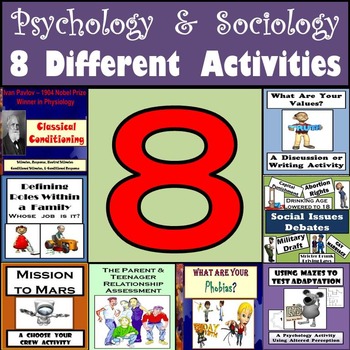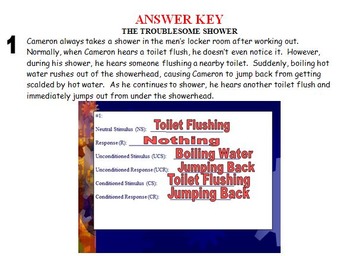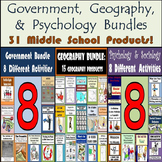Psychology & Sociology Bundle - 8 Different Activities for Middle School!
- Zip
Products in this Bundle (8)
showing 1-5 of 8 products
Also included in
- Middle School Geography, Government, and Psychology Bundle -- 31 Products! When I started teaching middle school Social Studies over 17 years ago I was given a text book that was outdated, at an advanced reading level, and did not provide any supplemental material. I found myself completely on myPrice $29.99Original Price $57.74Save $27.75
Description
Psychology and Sociology Bundle. This Psychology and Sociology bundle is filled with resources for you to use as you guide your students through these two behavioral sciences. Enjoy!
Classical Conditioning PowerPoint, Activity, and Worksheet
Yes, a student will be Pavlov's Dog. This is a fun way for students to learn the steps involved in Classical Conditioning. I have used this activity for over a decade and it never fails. The terms stimulus, response, neutral stimulus, unconditioned stimulus, unconditioned response, conditioned stimulus, and conditioned response are all incorporated in the lesson. There is a pre-teaching activity that involves using a student as Pavlov's dog and the script that I say during the activity as well as dog ear and nose props for you classroom "Pavlov's Dog." The next step is a PowerPoint I use to teach the basic concepts with a practice scenario included. Finally it is time for the students to show their understanding by identifying the terms of Classical Conditioning and coming up with a scenario of that incorporates all aspects of Classical Conditioning as well. I remember when I first learned about Classical Conditioning I was confused as to what parts of the scenario went with which term which is why I made this activity, PowerPoint, and worksheet to try and take the confusion out of the equation. I hope you and your students enjoy the lesson!
Defining Roles in a Family - Who Should Be Responsible for Certain Tasks?
Want a fun way to get students to figure out if they believe there are gender-specific tasks in a family? This is a combination self-reflection activity with a writing component at the end.
In this activity students will look at 20 different tasks that could take place within a household and have to place that task in the category they believe it fits. The categories are in a Microsoft Word document that the students can actually click and drag under the categories of either HUSBAND, WIFE, or EITHER OR BOTH. An example of options for them to choose from are "Shoveling Snow", "Changing Diapers", and "Grocery Shopping." For your students to "click and drag" you will have to save this document in a place on your school's network that they will be able to have access to it, open it, and then save it either on a flash drive or in their own personal space on the network. Students can stretch or shrink the choices so the words fit nicely in each category or they can make their own chart as well. There are many possibilities, this product provides a platform.
Students then defend themselves in writing by choosing three topics and supporting their reason why that task should be under the category they chose.
There will always be someone in class who is very stubborn on their beliefs, which has usually been a boy, who picks all of the stereotypical tasks such as sewing, changing diapers, or doing laundry as strictly tasks for the wife. This makes it very interesting when we discuss their choices as a class!
Mission to Mars: Psychology or Sociology Activity - Personality Characteristics
I absolutely love this activity! The purpose of this Mission to Mars activity is for students to take terms they've learned in an introductory Psychology class to choose 7 crew members out of a possible 12 to conduct a two-year journey to Mars and back. This activity was designed to not have a right answer. However, it is meant for students interpret psychological characteristics about a possible crew such as introvert, extrovert, intrinsic, extrinsic, optimist, and pessimist, and I.Q. to put together, in their mind, the best crew.
Students will have to decide if they will separate members of a family, send a member who has a terminal illness, or send a member with a light disability.
I've always enjoyed this activity because of how much my students talk to each other about why they would choose certain members and not others. This has been a hit every year. The classroom conversations about each member has always been very enjoyable.
Psychology Mazes to Test Adaptation with Different Perception
I'VE NEVER HAD A STUDENT NOT PARTCIPATE IN THIS ACTIVITY IN 15 YEARS!! This is a lesson I have used to teach students how we adapt to different circumstances by having them complete two different mazes six times. The mazes seem very simplistic at first until the students find out how they have to complete the mazes.
This activity could be used in a variety of classes. Math for charting information as well as figuring out averages, English as a writing prompt regarding something they have had to adapt to in life, Social Studies for seeing the world differently, or Science for a lesson on reflection. It is a pretty versatile lesson that takes very little to set up and is a fun activity to do with students to help them understand the point you are trying to make.
Phobias Lesson, PowerPoint, Worksheet, and Activity
I have used this Phobias lesson for years in my 7th Grade Social Studies class when we are studying fear in our Psychology Unit. This Phobias lesson involves a PowerPoint that has students figure out how superstitious they are as well as try to guess 10 unique phobias by their scientific name then by images that represent the phobias. The students will then create an illustration that symbolizes a unique phobia by it's scientific name and a colorful illustration they create. The following day the class tries to guess the phobia they selected by the name and then by the illustration they created. This is one of those lessons that has been a golden oldie for me because every student voluntarily takes part in it and they always enjoy the next day trying to figure out what each other created. This also helps ease into discussions about what fears they have and how to address those fears. This could easily work in a Health class when discussing emotions or an English class to foster ideas for personal narratives. This also might be helpful for doing interdisciplinary work between the three.
The Parent & Teenager Relationship Assessment - A Guide to Better Communication
Do your teenage students every talk about struggles they're having with their parents? Maybe they want more freedom? Maybe they think their parents put too much pressure on them? This assessment will help bridge a communication gap between teenagers and their parents. Teenagers place a score between 1-5 next to 24 different statements regarding their own beliefs about how they feel their parents are treating them. There is a calculation that is performed at the end which places them in one of three different categories in regard to the status of their relationship with their parents.
If a teenager so chooses they can give their parents the assessment with the 24 statements flipped to have the parents score from their point of view. The same calculation is performed at the end and will place them in one of the same three categories.
Then the fun part. The parent and teenager sit together and share what their final score was. Then they can share their scores for each other 24 statements and discover where they are perceiving their relationship the same as well as differently. Each statement is a talking point and worthy of a conversation.
This has been tried and true with my teenage students and their parents. This activity can be especially helpful for teenagers who are looking for a way to talk to their parents but don't quite know how to start. This activity gives them a topic 24 different times. I have had parents call or e-mail and thank me for giving this to them because it helped bridge a communication gap they were experiencing.
This activity could also work well for counselors dealing with a family situation where parent and teenager are not seeing eye to eye. This may help them discover the areas that need improvement.
25 Social Issues Debates - Reading, Writing, & Speaking in Social Studies
Your students will have a formal debate on controversial social issues that are part of society today. This week-long activity is bound to ramp up your classroom discussions. I have done this type of activity for 15 years and look forward to it every time it comes around.
What I love about this lesson the most is that students get to voice their own opinions without being criticized by anyone. It provides them with a safe platform to talk about an important issue in history/today's society as well as an issue they feel passionately about.
Included in this activity are:
-25 Social Issues Debatable topics on Cardstock to be displayed
-Debate Survey for students to figure out what they believe
-Grading Evaluation that is simple and to the point
-Tips for Your Debate sheet to help students with writing
-Lesson Plan that explains what I have done for this activity
-Take Your Own Stance sheet for students to fill out during debates
The one thing I appreciate the most about the activity is the discussion that is held after the debates are concluded. For one full week the students will be focused on the social issues of today and hopefully by doing this activity they are more aware to the issues that face their generation in the world in which they live.
Values Activity - What Are Your Values? - Core Values Activity
The purpose of this activity is for students to get a better idea what they believe compared to what others in class believe about the things we value in life such as power, money, fairness, honesty, etc. This values activity works great for character education, health, psychology, sociology, or even as an ice breaker in the beginning of the year. Students will randomly choose from a list of questions that come with this lesson and share their answer to that question in the group. Ground rules of respect, quietly listening to each other, and appropriate behavior should be established and agreed upon first. Students answer when they are comfortable as explained in the lesson plan.
This has been one of my "golden oldie" lessons because students have always enjoyed themselves and truly learned a great deal about each other and practice their listening skills and acceptance skills.
Click the green star next to my store logo to follow Surviving Social Studies. Following my store simply means you'll get e-mail updates about new products, freebies, and when I'm throwing a sale. Thanks for visiting!
Enjoy!
For a GREAT classroom management tool check out one of my BEST-SELLERS!
Student Conferencing "Deli-Style"
Connect with Surviving Social Studies...
Be sure to follow my TpT store by clicking on the ‘Follow Me’ next to my logo to receive notifications of new products and upcoming sales.
Follow me on Pinterest
Follow me on Instagram
Follow me on www.survivingsocialstudies.com
Thanks for stopping by!
Surviving Social Studies
Terms of Use:
Copyright ©Surviving Social Studies. All rights reserved by author. This product is to be used by the original downloader only. Copying for more than one teacher, classroom, department, school, or school system is prohibited. This product may not be distributed or displayed digitally for public view. Failure to comply is a copyright infringement and a violation of the Digital Millennium Copyright Act (DMCA). Clipart and elements found in this PDF are copyrighted and cannot be extracted and used outside of this file without permission or license. Intended for classroom and personal use ONLY.






